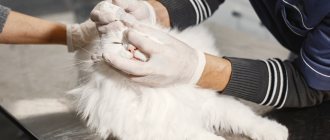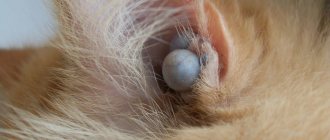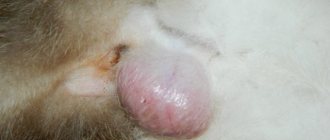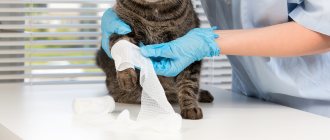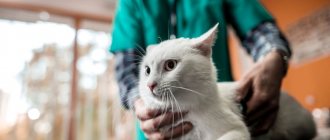- home
- Treatment
- Symptoms of cat diseases
- The cat has lumps under its skin
Bumps on a cat’s body always indicate pathology; of course, we do not mean injuries and bruises received during jumping. If you are sure that there was no mechanical trauma, but you find a lump on the cat’s skin, then this is probably evidence of the presence of a tumor.
The number and size of cones can vary greatly, as well as their location. If you find bumps on your cat, you should immediately take your pet to a veterinarian. If a cat has a pathology, the diagnosis of which is delayed, treatment will simply become ineffective and the cat will die.
Oncological tumor of the breast
Having discovered a tumor on the abdomen of an animal, the most dangerous cause – mammary gland cancer – should be excluded from the very beginning. Unfortunately, it occurs quite often in cats, as in people. The diagnosis is very scary. If the disease is detected late, its prognosis is unfavorable. The animal dies.
© shutterstock
Bumps with breast cancer appear on the belly in the area of the nipples. Most often the swelling is single, but there are also multiple formations. Sizes vary. The bigger the lump, the worse the situation. If seals appear on other parts of the body (for example, on the neck or limbs), then everything has gone very far - the animal’s body is affected by metastases.
A cancerous tumor in cats on the abdomen is characterized by the following features:
- hard to the touch;
- hot;
- grows quickly;
- in most cases – mobile;
- in the initial stages, the skin over the bump is of normal color, and in the later stages it turns red or purple;
- with advanced cancer, the lump bleeds.
It is quite difficult to detect oncological lesions of the mammary glands in a cat at the initial stage. The animal behaves as usual, eats normally, plays. Pronounced changes in behavior appear later, when the disease is advanced. In order not to let this happen and not lose your pet, you need to constantly examine it and show it to a specialist at least once a year. If you find a lump, be sure to take your cat to the vet.
Cancer at an early stage can be cured. In such cases, surgery is performed. The prognosis largely depends on the age of the animal, the general condition of its body, the skill of the surgeon and the quality of care of the owners. At later stages, specialists no longer undertake to treat cats with oncology.
Lipoma
A lump on a cat's stomach may be a common lipoma (subcutaneous fat). This is also a tumor, only benign. She is not life-threatening. Features of lipoma bumps :
- round form;
- quite large sizes;
- soft consistency;
- does not grow rapidly;
- mobile (moves under the skin when pressed, glides easily).
A tumor on the abdomen can cause discomfort to the cat: it itches or interferes with movement. Especially if it is large. In such cases, the lipoma is removed surgically. If the lump is relatively small and does not bother the cat, they try not to touch it.
© shutterstock
However, before you calm down, you should make sure that it is a lipoma. It is imperative to show the animal to a veterinarian and undergo an examination to rule out more serious diseases.
Signs
The cause of the appearance of a lump under the skin of a cat can be cancerous tumors, lymphadenitis, hernias, benign tumors (lipomas, wen, papillomas, fibromas).
Cats are often diagnosed with lumps under the skin that develop as a result of inflammatory processes of the skin - furunculosis, folliculitis, carbuncles, abscesses, and phlegmon. The cause of a cone in a cat can also be the bite of a poisonous insect - a wasp, bee or bumblebee.
Depending on what type of tumor the animal has under the skin, the symptoms will be different. If a ball is found under the skin of a cat's neck, the cause may be a benign or malignant tumor. The main signs of benign neoplasms are:
- long-term development;
- a clear boundary between healthy and modified tissue structures;
- presence of encapsulation;
- absence of metastases;
- roundness of shape and smoothness of surface.
Malignant neoplasms are characterized, on the contrary, by rapid growth, the presence of sites of stasis and the occurrence of ulcerations. Balls under the skin associated with malignant tumors have a bumpy surface with areas of necrosis of tissue structures.
A tumor diagnosed under the skin on the cat’s abdomen may well turn out to be a benign formation – a lipoma. The main differences between this neoplasm and a malignant one are the absence of rapid growth, soft structure, and roundness of shape.
A characteristic feature of a lipoma is its ease of movement, as if a ball were rolling under the skin of a cat. Lipoma does not require immediate removal. In the vast majority of clinical cases, the neoplasm is systematically monitored by specialists.
Surgical intervention is prescribed only if the location of the lipoma begins to cause discomfort to the animal - it itches, greatly increases in size, and in every possible way interferes with the cat’s usual activities.
To differentiate a lipoma from a possible malignant neoplasm, it is advisable to perform a biopsy, as well as laboratory tests of the animal’s blood and urine.
Skin pathologies
A lump on a cat's stomach may be one of the skin diseases that are divided into benign and malignant. The first group of ailments includes :
- Boils are inflammatory processes in the hair follicle. The lump is small and painful at first. Over time, it increases to 1-1.5 cm due to the accumulation of pus. At the final stage it is opened. Pus flows out.
- Folliculitis is an inflammatory lump with pus. It is a small nodule on the abdomen. It develops due to ingrown hairs, the skin around which turns red and swollen.
- A carbuncle is a lump covered with multiple blisters containing purulent fluid.
- An abscess is an inflammation resulting from a bacterial infection that has gotten under the skin. Pus accumulates in a limited cavity. Spread of infection to adjacent areas is rare. Sometimes it does end up in the blood or lymph. An abscess lump is usually painful. Often accompanied by an increase in temperature.
- Phlegmon is a diffuse purulent inflammation. The lump is very painful. The skin over it is red.
Treatment of benign neoplasms on a cat's abdomen is usually conservative. Therapy includes ointments, creams and other similar products for external use. Surgery is very rarely required.
Malignant lumps on a cat's abdomen grow rapidly. They are dense, covered with bumps and ulcers. Skin necrosis is observed in some areas of the tumor. The seals are movable. Treatment is surgical. The prognosis depends on the stage.
Bleeding lump on a cat's stomach: Treatment
In the case of an abscess that has opened, the owner may notice blood and pus on the fur in the animal’s habitat. The condition may also be accompanied by fever, lethargy, and loss of appetite.
In this situation, the veterinarian will perform surgical treatment of the wound under general anesthesia. A drainage tube may be placed to flush out the abscess cavity. Before giving anesthesia, it will be recommended to conduct blood tests and a screening ultrasound examination of the heart.
It will be recommended to wash the wound, most often with saline solution, Chlorhexidine or Betadine . It may be necessary to add Levomekol . And of course, it is necessary to prescribe a systemic antibiotic in the form of tablets or injections. The prognosis, if you go to the clinic in a timely manner, is favorable.
If the cause is a tumor that has opened, then the prognosis varies from cautious to unfavorable. A bleeding tumor is a bad sign, indirectly indicating the duration of the process and the possible malignant nature of the tumor.
Necessary medications
To decide what treatment is required, surgery or chemotherapy, diagnostics are required:
- Donating blood for clinical and biochemical analysis . In addition to the neoplasm, there may be concomitant pathologies, for example, liver and kidney diseases. Based on the results, the doctor will decide whether such a patient can be given anesthesia, and if so, what kind.
- Screening ultrasound of the heart . Necessary for the same reasons as blood.
- Cytological examination of the neoplasm . To clarify the nature of the process. The method does not give a 100% result, but it is necessary to make the right decision.
- Survey x-ray of the chest cavity in four projections . To exclude metastasis of a mammary gland tumor to the lungs. This organ is the first target of metastases.
- Ultrasound examination of the abdominal cavity . Used to assess the structural condition of internal organs and detect/exclude other neoplasms.
- CT scan . A more effective, but expensive way to exclude metastases in the body.
After all the research has been carried out, the cat owner, together with the doctor, decides on treatment. What are the options? Often the owner is interested in whether it is possible not to conduct research, but to immediately undergo surgery to remove the tumor.
It is possible, but without diagnosis no one can talk about the prognosis, relapse, or whether the animal will undergo surgery. The owner must make the decision independently.
However, if you decide to conduct research, then possible treatment options are presented below:
- If metastases are detected or there are contraindications for anesthesia, then neither surgery nor chemotherapy is performed. In this case, local treatment of the opened neoplasm is used to avoid sepsis or a decision is made on humane euthanasia.
- Based on the results of the studies, they decide whether to do a total mastectomy - the complete removal of a ridge of mammary glands, or to perform a resection of only one package.
- Chemotherapy treatment, if the type of tumor allows it.
After removal of the tumor, it is recommended to send it for histological examination. This is necessary for a more accurate determination of the type of tumor and for further prognosis with the likelihood of relapse.
In the case of tumors not associated with the mammary glands, the procedure is the same.
Watch the video: Bumps in cats - Advice from a veterinarian
Lymphadenitis in cats
A lump may appear on a cat's stomach if the inguinal lymph node becomes inflamed. The cause is an infection leading to diseases of the genitourinary system. With lymphadenitis, compaction is characterized by the following features :
- oblong shape;
- soreness;
- immobility;
- the skin over the bump is hot.
If such a tumor is discovered, the cat should definitely be shown to the doctor. The disease that causes lymphadenitis requires treatment. Antibiotics, anti-inflammatory drugs, preparations with vitamins, iron, magnesium, potassium and other beneficial substances that help strengthen the immune system may be indicated.
Symptoms of lymph node inflammation are similar to cancer. Cancer can only be ruled out by diagnostics, so a trip to the clinic is essential.
Hernia
If a cat has a lump under the skin on its stomach, this may indicate a hernia, which is localized in the groin. The formation comes in different sizes - from tiny to 5-6 cm. Sometimes it is located in one place, and sometimes it “migrates” within the groin. In this case, the lump can behave differently.
© shutterstock
In some cases, hernial tumors are very painful, while in others they do not bring any discomfort to the pet at all. The temperature of the skin over the lump may increase greatly or remain normal. The tumor itself can be hard or soft.
In any case, a hernia is serious. Therefore, the cat needs to be examined by a veterinarian and treated, which is often surgical. If the hernia is small and does not bother you, conservative measures are used. Massage, special fixing bandages, etc. are prescribed. A dangerous complication of a hernia is its strangulation. It leads to inflammatory processes in surrounding tissues.
If your cat has a hard belly rather than a soft belly
Anyone who owns a cat is well aware that a cat has a particularly soft part of its body: its belly, which is unsurprisingly called “soft.” Some also call it a "pouch". This area of the body is nothing more than a growth that cats have in the lower abdomen. Although a cat's body is inherently elegant, agile and fit, this area always remains the softest and most saggy: this is not a disease or a malformation.
When a cat undergoes spay surgery, the empty space in the gonads or ovaries causes a hormonal decline. This way the tissues relax and the stomach appears softer. Of course, this is not the fat that remains attached to your belly after a serious diet. But then why can a cat have a hard and often swollen belly? Answers in the next paragraph.
© shutterstock
Mastitis
If a lump is found on a female's belly, it may be mastitis. Most often it develops in cases where kittens are taken away from their nursing mother too early. The cat suffers greatly from stagnant processes. Her mammary glands are very sore, her body temperature reaches high levels, the animal loses appetite and sleep, and quickly becomes exhausted.
Mastitis bumps are red. They are very hard to the touch and hot. Located near the nipples. When pressed they increase in size. Sometimes milk with purulent impurities is discharged from the nipples. In other cases it disappears completely.
Mastitis does not always occur after childbirth. It can result from mechanical damage to the nipples, false pregnancy, or some gynecological pathologies. Requires veterinary assistance. Treatment depends on the form and extent of the disease. In uncomplicated situations, you can get by with ointments and compresses; in severe situations, you have to resort to radical measures.
Differentiation of buds
Breast cancer in a cat
There can be from one to several nodules - they are all of different sizes, most often localized in the area of milk bags closer to the groin. Tumors can be located not only on the abdomen, but also found on the limbs, neck, and back, which already indicates the metastasis of cancer cells throughout the body.
The neoplasms are dense, hard, sometimes hot to the touch, over time (closer to the last stage of cancer) they turn red, take on a purple-pink color, bleed and purulent discharge is released from them. The seal can also “walk” under the skin, that is, move freely.
It is necessary to constantly monitor such bumps and notice the dynamics of changes:
- tendency to increase swelling;
- how quickly does growth occur;
- whether the appearance of education is changing.
It is worth noting that cats are most often diagnosed with malignant tumors that progress and literally devour their beloved pet before our eyes.
The general condition at the onset of the disease may not change: the cat still feels well and has an excellent appetite. But as the oncological process develops, the animal loses weight, refuses to eat, is depressed and apathetic.
Mostly older people get sick, especially those who have been receiving anti-sexual hormonal pills or injections for a long time. Unsterilized animals are also at risk.
Treatment is surgical. But no one can guarantee a complete cure. Recovery depends on many factors:
- pet's age;
- the state of his immune system;
- stage of cancer;
- qualifications and experience of a veterinary surgeon;
- the correctness of the rehabilitation measures carried out.
Typically, surgery only helps to prolong the pet’s life by a few months, as well as reduce discomfort and pain from interfering lumps. In veterinary practice, there have been cases of complete relief from cancer, but there are very few of them - literally one in several thousand.
Feline lipoma
Wen is a benign tumor enclosed in a capsule, which, unlike malignant neoplasms:
- not prone to rapid growth;
- soft, doughy to the touch;
- moves easily under the skin;
- has a round or oval shape;
- easy to treat and does not metastasize.
The lipoma is not removed, but simply monitored. Surgical intervention is resorted to only in cases where the swelling causes a lot of trouble for the pet: it interferes, itches, or becomes too large.
Although subcutaneous wen does not pose any mortal danger to the animal, to be completely sure, it is still worth conducting additional research: taking a puncture for a biopsy and taking blood and urine tests.
New growths on the skin
They can occur on any part of the body, including the stomach. Downstream there are:
- benign - develop slowly, have a clear boundary between healthy and changed tissues, as a rule, there is a capsule and there are no metastases. In terms of shape and size, the cones usually reach enormous sizes and are round in shape with a smooth surface;
- malignant - they are characterized by rapid growth, the appearance of ulcers and metastasis. The growth is dense, the surface is bumpy, with ulcers, pus, areas of necrosis, it grows in breadth and is mobile in relation to adjacent tissues.
Bumps for skin diseases
At the beginning of the article, it was already stated which skin diseases can cause swelling, so now we’ll just focus on their appearance, without going into details of the causes and treatment.
- A furuncle is an inflammation of the hair follicle, in which a painful swelling first appears, reaching the size of a hazelnut. As the process resolves, the apex of the formation is opened, pus is released, followed by the formation of an ulcer.
- Folliculitis - a nodule and redness form around the hair, and then a blister with pus appears inside.
- Carbuncle – a dense inflammation forms, occupying a large area of the body, with a large number of purulent blisters on the surface.
- An abscess is the formation of a purulent cavity protruding above the skin.
- Cellulitis is a painful, diffuse, hot, dense red swelling with areas of fluctuation (squelching, swaying when pressed).
Lymphadenitis
The role of a lump on the abdomen in this pathology is played by the inguinal lymph node, which is inflamed as a result of:
- infections;
- mastitis;
- gynecological or andrological diseases;
- inflammation of the genitourinary system;
- hypothermia, etc.
The inflamed lymph node is a compacted oblong ball, painful, immobile and hot to the touch, which can be felt on the inside of the thigh closer to the groin. Medical errors also occur when a swollen and painful milk bag in cats is mistaken for an enlarged lymph node.
Hernia lump
The protrusion can be of different sizes (from a pea to a chicken egg and even larger) and is localized in the groin, navel, and perineum. Depending on the presence or absence of infringement, it happens:
- movable and immobile;
- reducible and irreducible;
- painful and painless;
- hot and normal temperature;
- soft and dense;
- constant size or changing depending on meals or the location of the body in space;
- strangulated hernias tend to increase due to inflammation of surrounding tissues.
A professional doctor, upon visual examination, will quickly determine what kind of lump it is - a hernia or a neoplasm. Treatment:
- none - in the case of perineal bulges in cats (in females, prolapse of the uterus in the groin can lead to infertility due to incarceration and tissue necrosis);
- conservative – massage, supportive bandage;
- surgical – excision of the hernial sac, repositioning the organs in place and subsequent suturing of the hernial opening.
Swelling due to mastitis
Signs of mastitis can be observed during false pregnancy.
Mastitis is an inflammation of milk bags that occurs against the background of:
- mechanical damage to the nipples or the gland itself;
- stagnation as a result of heavy lactation, premature weaning of kittens;
- diseases of the genital organs (endometritis, pyometra, etc.).
The mammary gland (individual packages or all at once) increases significantly in size, becomes hot, hard and red. Milk may not be released at all due to pinched ducts, or it may acquire a crumbly consistency with admixtures of pus or flakes. With abscess formation, the areas of inflammation become even larger, filled with pus and fluctuate (squelch, spring back when pressed).
Signs of mastitis can appear during a false pregnancy, so the appearance of lumps, nodules and lumps in this case must be differentiated from oncology.
Treatment depends on the severity of the disease. It could be:
- use of compresses;
- use of novocaine blockade;
- prescription of antibiotics;
- physiotherapy to eliminate congestion (massage, electrical stimulation, etc.);
- careful expression of milk;
- in some cases surgery is indicated.
Signs of inflammation of the paraanal glands
The glands are paired and are located on both sides of the anus. Under certain conditions they can become inflamed, causing discomfort in pets.
In appearance, the inflammation is similar to a perineal hernia in castrated cats, only in the second variant the lump changes its size and shape depending on the horizontal position of the body in space:
- upside down (back legs up) – decreases;
- upside down - increases.
Lump on a cat after sterilization
May appear for a number of reasons:
- with inept suturing;
- premature resorption of suture material;
- untying of internal threads for some reason;
- with improper care of the surgical wound, when the cat is allowed to constantly lick or bite the surgical wound.
Internal organs, often intestinal loops, protrude through the resulting hole. The sac, as a rule, is movable, low-painful, and easily retracted back into the abdominal cavity. It is treated by installing a new “patch” on the surgical wound.

